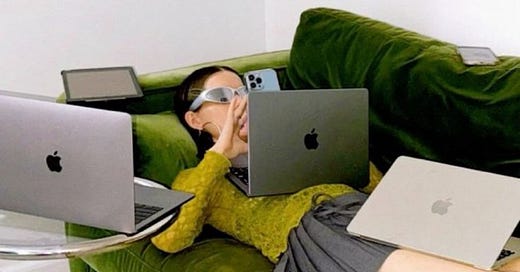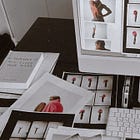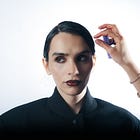Hi everyone,
A new newsletter in my series about breaking into the industry as an art director. This is probably one of the most important ones. I’ve also gone back and unarchived the first two parts of the series linked below to be available for everyone forever. In this 6 part series I combine all my knowledge of working as an art director and help you break in quicker, grow quicker but also maybe make a career switch if you are seeking one.
These are my favourite to write, because when I started out the industry felt so secretive and I felt overwhelmed on how to get my dream job. In a way it still is very much, but I’m spilling a lot of the secrets today.
There are lots of insights in this one, so let’s jump right in!
Everything Networking!
In the last two parts of this series, we covered what it means to be an art director and the essential skills needed to build your foundation. From understanding the different types of art direction to developing the technical and soft skills that will set you up for success, we've laid out the first steps for breaking into the industry. Now that you have a solid grasp of the role and the basics, it’s time to dive into one of the most important—and sometimes overlooked—parts of the journey: networking.
Networking isn’t just about attending industry events or knowing the right people. It’s about building meaningful connections, collaborating with others, and staying visible in the creative community. Whether it’s engaging on social media, reaching out to mentors, or meeting people at events, networking is often the bridge between where you are now and where you want to be. In this part of the series, we’ll explore how to make connections, nurture them, and use networking to push your career forward.
Who to Network With
From my experience, many full-time art direction roles are filled before they’re ever listed publicly. Positions often go to people who’ve already introduced themselves or been recommended by others. Being on someone’s radar—whether it’s a recruiter, creative director, or producer—makes all the difference. People like to hire those they know or trust through a recommendation, which is why staying visible and building relationships is key.
As an art director, networking goes beyond just connecting with recruiters. Building relationships with creative directors in advertising, film directors, photographers, set designers, and stylists is crucial since they help bring your vision to life. Many of my opportunities have come from consistently introducing myself, setting up calls for future projects, and staying on people's radars, even when there’s no immediate job offer. Keeping your portfolio updated, working on personal projects, and discovering new talent (via Instagram, upcoming brands, or magazines) is essential to remain relevant.
Where to Network
You don’t need to be an extrovert to network effectively. I’m quite introverted myself, and while I wouldn’t feel comfortable approaching someone at an event or cold-calling, I’ve found success through LinkedIn and Instagram. I typically reach out to creative directors or producers on LinkedIn after researching who handles the creative direction at a company. On Instagram, I follow people in the industry, like their posts, and engage before making an introduction.
Workshops and networking events can also be great, but I’ve found that the more organized ones yield the best results. Once you get a few projects under your belt, your network naturally grows through word-of-mouth, introductions, and following people from the call sheet on social media. Networking doesn’t have to be daunting—just find a method that fits your personality and ease into it.
Starting from Scratch
If you’re just starting out, finding a mentor can be incredibly helpful. However, your mentor doesn’t have to be someone at the top of the industry. Instead, look for someone 1-2 steps ahead of you who’s willing to provide feedback and guidance. Build your portfolio by collaborating with people at a similar level—a photographer building their portfolio, a set stylist fresh out of school, etc. Pitch these projects to small magazines or simply use them to create a body of work that shows your potential.
Once you’ve built a foundation, apply for internships or participate in industry award shows like D&AD or Young Lions, which helped me get my first foot in the door. Share your work through social media, Substack, or TikTok, showing your creative process to reach a broader audience. Eventually, start reaching out to studios, start-ups, or recruiters for junior roles.
Crafting the Perfect Message
When reaching out to agencies or potential clients, personal messages on LinkedIn or email work best. If you can’t find the right contact, emailing the agency’s general inbox can still get your work noticed. Always address the person by name and tailor your message to align with their work—don’t pitch yourself to a luxury fashion agency if your portfolio is primarily streetwear, unless you can make a clear case for why you’d fit.
Keep your message short and to the point. A simple introduction, one or two sentences about your unique selling point, and a request for something specific is enough. You might ask a creative director for a quick call to introduce your work or suggest a coffee meeting with a producer to discuss potential future collaborations. Don’t mention rates unless asked, and if you don’t have big client names to share yet, just link your portfolio and let your work speak for itself.
Stay Consistent
Even if someone doesn’t respond, don’t be discouraged. Follow up after at least six months when you have new work to show. For those who did reply but didn’t result in a job, check in after three months with updates on your latest projects or to see if any opportunities have opened up. Persistence is key—people are busy, and sometimes they need a reminder to keep you in mind.
Who to Network With
Creative Directors: They’re often decision-makers in hiring art directors and can offer job opportunities, feedback, and mentorship.
Producers/Project Managers: These people manage projects and may be responsible for suggesting creative talent. They also track rates and can recommend you for future jobs.
Photographers: Essential collaborators for fashion, editorial, or advertising work.
Set Designers & Stylists: Help bring your creative vision to life during shoots.
Film Directors: Crucial for projects in motion, including commercials and short films.
Copywriters: Partnering with a copywriter can lead to freelance projects or team positions, especially in advertising.
Recruiters: Great for getting your foot in the door for full-time roles or keeping you in mind for future openings.
Other Art Directors: Connecting with peers can lead to shared opportunities or job referrals.
In conclusion, networking is a vital skill for any art director, but it’s not a one-size-fits-all approach. Whether you're introverted or extroverted, there's a way to network that works for you. Stay consistent, keep refining your portfolio, and always be open to new connections. With time and persistence, you’ll build the relationships that help push your career forward.
Please share this post with anyone you know that this could be insightful to. Also to celebrate hitting 2k subscribers last week, I am giving away two paid subscriptions for a lifetime. All you have to do is comment your favourite artist or photographer in the chat (and extra love if you share the newsletter or recommend it on yours and I will raffle two people. The deadline is tomorrow 00:00 CEST, on Sunday I will announce the two winners.
Love, Zoe














Love this! One of my fav photographers is Laura Gilpin, early 1900s US photographer.